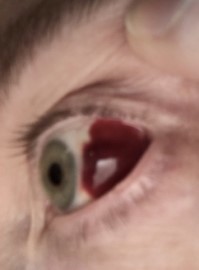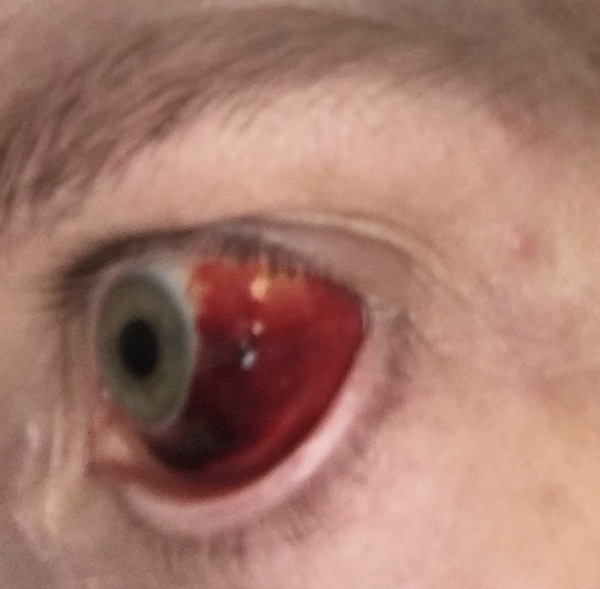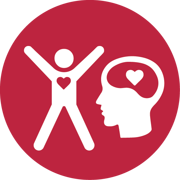
Last Tuesday when I woke up I lightly rubbed my eye a bit since it felt like there was something in it, then when I looked in mirror I saw this red blob in the corner of my eye.
Needless to say we were a tiny bit freaked but, after Bill and I did a quick search, we learned it’s called a subconjunctival hemorrhage (sub-kun-JUNK-tih-vul HEM-uh-ruj).
According to the Mayo Clinic, a subconjunctival hemorrhage occurs when a tiny blood vessel breaks just underneath the clear surface of your eye (conjunctiva). It’s like having a bruise on your skin, but the conjunctiva can’t absorb blood very quickly, so the blood gets trapped.
Mayo goes on to say… despite its appearance, the eye bleed looks worse than it is and should cause no change in your vision, discharge or pain. The only discomfort may be a scratchy feeling on the surface of the eye.

I didn’t have any pain or swelling and the blood was only in the
white part of my eye that first morning. Since then blood has spread
across most of my eye.
We also noticed a tiny bump by my outer eye a few days later so it’s possible it was a bug bite, but no issues or pain.
But I sure look weird – esp. with makeup on one eye and the other
looks … just gross.
Too bad it didn’t happen a few weeks ago since it would’ve been cool for Halloween. Cedars-Sinai says most people will not need any treatment and the subconjunctival hemorrhage will go away in a few weeks. It will turn from red to brown then to yellow.

Now … since we’re on the topic of eyes, we also wanted to share some first aid tips about Eye Injuries in general from our preparedness and first aid manual.
Things to watch for...
Severe or constant pain or burning
Object stuck in the eye (like a piece of metal or glass)
Redness and swelling
Blurry vision, trouble keeping eye open, light sensitive
Vapors or fumes in the air
What to do...
- Avoid rubbing eye since this can cause more damage.
- Have victim sit down with their head tilted backwards.
- Wash hands before touching eye area.
- If injury is from a chemical, make a note of the name for Poison Control if possible.
If the injury is a loose foreign object:
- Gently separate eyelids to see if you can locate a foreign object – can try removing it by wiping gently with damp tissue.
- Ask victim if he/she wears contact lenses, and if so, ask him or her to remove them.
- Have victim lean over sink or lie on back, hold eye open, and gently flush eye with lukewarm water or a saline solution.
- Get medical help if you are not successful.
If there is an object sticking out of the eye:
- Put thick soft pads around the object that is sticking out.
- DO NOT try to remove or press on the object!
- Carefully wrap with a roller bandage to hold thick pads around the object.
- Get medical attention immediately!
If injury is from a blow to the eye:
- Apply an icepack to reduce pain and swelling.
- Seek medical attention if damage to eye or blurred vision.
If the injury is from a chemical:
- Call your local Poison Control Center (or 1-800-222-1222 in the U.S.) and have name of chemical handy, if possible.
- If victim is wearing contact lenses, ask Poison Control if they should be removed and whether to keep or dispose of them! If okay and able to take out, ask victim to remove lenses.
- Have victim lean over sink, lie down, or get in shower – hold eye(s) open, and gently flush with lukewarm water for at least 15 minutes. (If only one eye has chemical in it, make sure head is turned so it doesn’t pour into the other eye.)
- Tell victim to roll eyeball(s) around while flushing to wash entire eye.
- DO NOT press or rub the eyes!
- May want to cover eyes with clean dressing & bandages but ask Poison Control or check label on bottle. For example, if chemical is mustard gas (sulfur mustard) you should not cover eyes … but wear shades to protect them.
- Get medical attention immediately!
Things you should NOT do...
- DO NOT try to remove an object that is stuck into the eye!
- DO NOT try to remove their contacts (if any)… let the victim do it!
- DO NOT try to move the eyeball if it comes out of the socket!
Things you SHOULD do...
- Protect your eyes with safety glasses or goggles when playing sports or working with tools or chemicals … and wear shades during the day (to help reduce UV exposure).
- When an eye injury occurs, have an ophthalmologist (an eye physician and surgeon) examine it as soon as possible. You may not be realize how serious an injury is at first.
Find more first aid and preparedness tips in USFRA’s Family Preparedness and First Aid ebook (288-page PDF only $5) and download a free 68-pg portion of it at www.usfra.org/fedhealth (Proceeds benefit USFRA and our nation’s heroes.)




